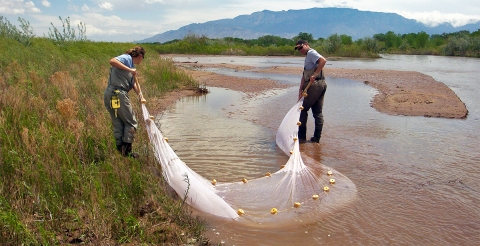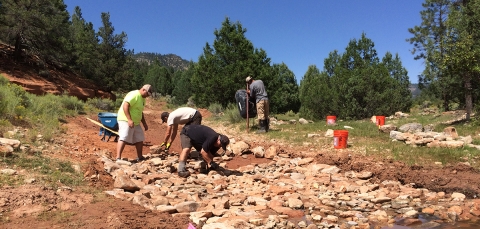Projects and Research
Rio Grande
The New Mexico Fish and Wildlife Conservation Office conducts research and long-term monitoring investigations of fishery resources in the Rio Grande Basin and provides technical management expertise to other federal agencies and Native American Tribes and pueblos. Within the Rio Grande Basin, these projects are mostly related to conservation of the federally endangered Rio Grande silvery minnow (Hybognathus amarus).
San Juan River
The San Juan River is home to two federally endangered fishes, Colorado pikeminnow (Ptychocheilus lucius), and razorback sucker (Xyrauchen texanus). While historically found throughout the Colorado River Basin, both species vanished from the San Juan River by the 1990s. Our office collaborates with the San Juan River Basin Recovery Implementation Program (SJRRIP), a multi-agency cooperative recovery program, to reestablish these species in the San Juan River. Examples of our ongoing management efforts aimed at restoring these populations include stocking hatchery-reared fish, monitoring their survival and recruitment, and removing non-native species that have been identified as harmful to their recovery.
Gila River Basin
Recovery activities in the Gila River Basin embody the concept of landscape scale conservation through diverse partnerships and range-wide management approaches in dealing with environmental threats such as wildfires, climate change climate change
Climate change includes both global warming driven by human-induced emissions of greenhouse gases and the resulting large-scale shifts in weather patterns. Though there have been previous periods of climatic change, since the mid-20th century humans have had an unprecedented impact on Earth's climate system and caused change on a global scale.
Learn more about climate change , and non-native species invasion. Agency personnel conduct and participate in basin-wide monitoring, outreach, fish evacuations, and stocking events for threatened and endangered fishes including Gila trout (Oncorhynchus gilae), loach minnow (Rhinichthys cobitis), spikedace (Meda fulgida), and Chihuahua chub (Gila nigrescens).
Pecos River
Our office has annually collected long term, systematic fish community data on the Pecos River since 1992. The primary objective of Pecos River fish community monitoring is to track spatial and temporal changes in relative abundance of the Pecos bluntnose shiner (Notropis simus pecosensis). This data is used to ensure that water management actions for the Carlsbad Irrigation District Project are not negatively affecting the species. The monitoring data has validated the species’ need for continuous river flows to ensure that the relative abundance of the Pecos bluntnose shiner (and other mainstem habitat specialists) remains at sustainable levels.
Tribal Assistance
Our office works with 22 federally recognized Tribes and pueblos, on fulfilling and upholding the agency’s Tribal trust responsibilities. As part of our technical assistance to Tribes, we assist with lake, stream and river surveys, habitat assessments and improvements, fish passage fish passage
Fish passage is the ability of fish or other aquatic species to move freely throughout their life to find food, reproduce, and complete their natural migration cycles. Millions of barriers to fish passage across the country are fragmenting habitat and leading to species declines. The U.S. Fish and Wildlife Service's National Fish Passage Program is working to reconnect watersheds to benefit both wildlife and people.
Learn more about fish passage , native fish conservation, non-native fish removal, Tribal educational outreach, coordination meetings, employment opportunities through Tribal Youth Conservation Corp (YCC) programs, and Endangered Species Act collaboration. We maintain long-term Tribal partnerships that have spanned over five decades. These partnerships have allowed New Mexico tribes to expand conservation, recreational fishing, educational outreach and employment opportunities for Tribal youth.


